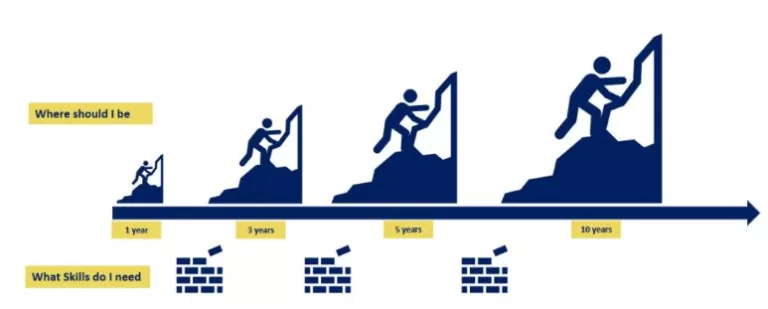The Ultimate Guide For a Successful IT Career Switch

It’s no secret that a career in IT comes with a lot of benefits like good pay, flexible work hours, opportunities of professional development etc. However, to make a transition to this competitive industry, you need to be prepared and do your research. Also, you need to build a career change CV that properly demonstrates your skills and determination – a good CV writing service can certainly help with that!
This is a comprehensive guide for anyone considering a career switch in IT. It covers the most common scenarios when people want to switch and provides everything, they need to know about making the transition.
1. Know Why You Want To A IT Career Switch
The first step in making any IT career switch is understanding why you want to make the move. What are your motivations? If you’re unhappy in your current position, what specifically do you hope to change by switching careers?
Before you can move forward, it’s important to have a clear idea of what you want to achieve by making a change. Otherwise, you may find yourself disappointed with your new career, or quickly become disillusioned and want to switch back.
Some professionals may want to switch careers because they are no longer challenged by their current job. They may also want to switch because they are not getting paid what they are worth, or because they don’t enjoy the work.
Some of the most common reasons include
1. They’re bored with their current role
IT professionals often find that they become bored with their current role after a few years. This is especially common in roles that are heavily technical or that don’t involve much interaction with other people. If you find yourself in a job that you no longer enjoy, it may be time to switch careers.
2. They’re not challenged enough
If you’re not being challenged in your current role, it can be easy to become disengaged and unmotivated. If you’re looking for a new challenge, switching careers may be the right move for you.
3. They want to learn new skills
IT is a rapidly changing field, and it’s important to keep your skills up-to-date. If you’re looking to learn new skills, switching careers is a great way to do so.
4. They want to advance their career
If you’re looking to advance your career, switching careers may be the best way to do so. In many cases, IT professionals find that they can move into management or other leadership roles by switching careers.

5. They want to make more money
In many cases, IT professionals find that they can increase their earnings by switching careers. If you’re looking for a pay raise, switching careers may be the best way to get it.
6. They want better work/life balance
IT can be a demanding field, and many professionals find that they need to sacrifice their personal life in order to succeed at work. If you’re looking for a better work/life balance, switching careers may be the right move for you.
7. They want to change location
If you’re looking to relocate, switching careers is often the best way to do so. In many cases, IT professionals find that they can easily transfer their skills to another city or country by switching careers.
8. They want different hours
IT professionals often find that they need to work long hours in order to succeed in their career. If you’re looking for a job with different hours, switching careers may be the right move for you.
9. They’re burned out
IT can be a high-pressure field, and many professionals find that they burn out after a few years. If you’re feeling burned out, it may be time to switch careers
The list goes on.
Know exactly why you want to switch!
The next step is to figure out what you want from your new career. What are your goals and interests? What are you good at? What do you enjoy doing?
If you are not sure, read this section again.
2. What to do before you switch careers
Once you have a better idea of what you want, you can start researching different IT careers that fit your goals and interests. There are many resources available online, including websites and forums specifically devoted to IT careers.
Another great way to learn about different IT careers is to talk to people who work in those fields. Ask them about their job duties, skillsets required, and training needed. This will give you a better idea of what each career involves and whether it’s a good fit for you.
Finally, don’t forget to budget for your career switch. Training and certification can be expensive, so make sure you have enough money saved up to cover all expenses.

Some examples of potential career paths for Developers
1. Lead/Management roles
2. Data engineer
3. Business intelligence analyst
4. Big data engineer
5. Data scientist
6. Machine learning engineer
7. Cloud architect
8. DevOps engineer
9. Security analyst
10. Full stack developer
Some examples of potential career paths for Business Analysts
1. Lead/Management roles
2. QA Analyst
3. Release Manager
4. Data Analyst
5. Developer
6. Product Owner
7. Scrum Master
8. Project Manager
9. Change Manager
10. Business Consultant
Some examples of potential career paths for Software Testers
(sorry for the bias, more information added for Testers)
1. Software Developer
A software tester can switch to a software developer career path and use their in-depth knowledge of software to develop new applications.
2. Business Analyst
A software tester can also switch to a business analyst career path and use their understanding of software to help businesses improve their processes.
3. Project Manager
A software tester can also become a project manager and use their knowledge of the software development process to manage teams of developers.
4. Quality Assurance Manager
A software tester can also switch to a quality assurance manager career path and use their knowledge of testing to help ensure the quality of products.
5. Technical Writer / Operations support
A software tester can also become a technical writer and use their understanding of software to create documentation for users.
6. Support Engineer
A software tester can also switch to a support engineer career path and use their knowledge of software to help customers with technical issues.
7. Trainer
A software tester can also become a trainer and use their understanding of software to train other users on how to use specific applications.
8. Consultant
A software tester can also become a consultant and use their knowledge of software to advise businesses on how to improve their processes.
The options for a IT career switch is virtually unlimited.
3. How choose the IT careers that may be a better fit for you
There are many different IT careers available, and it can be difficult to choose the right one for you. Here are a few tips to help you narrow down your options:

1. What are your goals and interests?
When choosing an IT career, it’s important to consider what you want to achieve. Do you want to lead a team of developers? Do you want to work with data? Or do you simply want to use your technical skills to solve problems?
It’s also important to consider your interests. Do you enjoy working with computers? Do you enjoy solving puzzles? Or do you enjoy working with people? Consider which IT careers fit your goals and interests.
2. What are your skillsets?
Not all IT careers require the same skillsets. Some careers may require more technical skills, while others may require more business skills. It’s important to consider which skillsets you currently have and which ones you will need to learn in order to pursue a certain career path.
3. What is the training required?
Many IT careers require some form of training or certification. It’s important to consider how much training is required and whether you’re willing to invest the time and money necessary to obtain the necessary qualifications.
4. What is the job market like?
The job market for IT careers can vary depending on the specific career. Some careers may be in high demand, while others may be more competitive. It’s important to research the job market for the specific career you’re interested in order to gauge your chances of success.
5. What is the salary potential?
IT careers can offer a wide range of salaries, from entry-level positions to six-figure salaries. It’s important to consider how much money you want to make and whether you’re willing to negotiate for a higher salary.
These are just a few factors to consider when choosing an IT career. By taking the time to consider your goals, skillsets, and the job market, you can narrow down your options and choose the IT career that’s right for you.
4. The steps you need to take to make the switch to a new career in IT

1. Figure out what you want to do
The first step in making a career switch is to figure out what you want to do. Do some research and think about what kinds of jobs are out there that interest you. Once you have an idea of what you want to do, you can start taking the steps to make the switch.
Also, in most large organizations it is possible to switch internally to a new department or role that may better fit your goals and interests.
Talk to your manager about your goals and see if there are any opportunities available within the company. Switching career tracks is usually much easier when done internally.
2. Get the necessary training
In many cases, you will need to get some training or certification in order to pursue a new career in IT. There are many ways to get the necessary training, including taking courses at a local college or university, attending training seminars, or getting certified by an industry-leading organization.
Ask your manager (if they are supportive), or Human Resources, if the company offers any training programs that could help you transition into a new role. Many companies have tuition reimbursement programs that can help offset the cost of taking courses.
3. Update your resume
Once you have an idea of what you want to do and the necessary training, you will need to update your resume. Be sure to include any relevant experience or skills that you have in order to make yourself a more attractive candidate for potential employers.
Every job that you apply for (internally and outside your current employer) deserves a tailor-made resume. You don’t want to send the same resume to everyone, as that will likely not highlight the skills and experience most relevant to each position.
4. Start networking
Networking is an important part of any job search, but it’s especially important when making a career switch. Attend industry events, meet with people in your field, and join relevant online communities. The more connections you make, the more likely you are to find a job that’s a good fit for you.
If you target to switch internally, start by talking to your manager. See if there are any open positions or upcoming projects that you could be a part of. If there’s nothing available, ask if there are any other departments or roles that you could be interested in.
5. Be prepared to interview
When you’re making a career switch, you may be interviewed by potential employers who are unfamiliar with your background. Be prepared to answer questions about why you’re making the switch and what qualifications you have that make you a good fit for the job.
Making a career switch can be a daunting task, but it’s possible to do if you take the time to figure out what you want to do and get the necessary training. By networking and being prepared for interviews, you can increase your chances of making a successful transition into a new career.
6. Be patient and stay focused
Making a career switch can be a long and difficult process, so it’s important to be patient and stay focused on your goal. It may take some time to find the right job, but if you stay dedicated and keep networking, eventually you’ll find something that’s a good fit for you.
5. Common challenges and obstacles you’ll face when making a career switch in IT
There are some common challenges and obstacles you may face along the way.

1. Lack of experience
One of the most common challenges you’ll face when making a career switch is lack of experience. You may find it difficult to convince employers that you’re qualified for the job when you don’t have the same level of experience as other candidates.
However, you can overcome this challenge by highlighting your relevant skills and experience on your resume and during interviews. Make sure to highlight any projects or tasks that you’ve done that are similar to the job you’re applying for.
The additional certifications can come to your aide explaining your interest and motivation to transition
2. Difficulty getting hired
When making a career switch, you may find it difficult to get hired by potential employers who are unfamiliar with your background. You will need to be prepared to answer questions about why you’re making the switch and what qualifications you have that make you a good fit for the job.
Try to move internally within the organization as current employers are usually willing to bet on you than new ones.
Expect this challenge. Stay focused , be patient and be dedicated to your job search. It might take some time, but if you don’t give up, you will eventually find something that’s a good fit for you.
3. Staying Focused on the current job
The biggest challenge you’ll face when making a career switch is staying focused on your current job. It can be difficult to balance your time and energy between your current job and the job search, but it’s important to stay motivated and dedicated to your goal.
Make a plan for how you’re going to balance your time and make sure to set aside enough time each day to work on your job search. If you’re struggling to stay focused, try breaking up your job search into smaller tasks that you can complete each day.
This is especially important if you plant to switch internally. You do not want your employers to think that you are less committed to your current job.
6. How to make the most of your new career
Once you’ve made the switch to a new career, it’s important to make the most of it. Here are a few tips for getting the most out of your new career.

1. Get certified
Many jobs in IT require certification, so it’s important to get certified as soon as possible. Certification shows employers that you’re qualified for the job and have the necessary skills to do the job well.
2. Stay up to date on technology
It’s important to stay up to date on the latest technology trends so that you can stay ahead of the curve in your field. Subscribe to tech newsletters, read tech blogs, and attend technology conferences to stay informed.
3. Network with other professionals
Networking with other professionals is a great way to learn more about your field and find job opportunities. Attend industry events, join online forums and social networks, and connect with professionals on LinkedIn.
4. Get involved in project work
Project work is a great way to learn new skills and expand your knowledge of your field. Try to get involved in projects that are related to your job or interest in order to gain experience and knowledge.
5. Be patient
It takes time to adjust to a new career, so be patient as you learn the ropes. Don’t get discouraged if things don’t go as planned at first, just keep pushing forward and learning as much as you can. eventually, you’ll find your groove and be successful in your new career.
6. Take advantage of resources
There are many resources available to help you succeed in your new career. Use online resources, such as job boards and career websites, to find job openings and learn more about your field. Additionally, many colleges and universities offer career services that can help you with your job search.
7. Seek out mentors
Mentors can be a great resource for advice and guidance as you adjust to your new career. Ask mentors questions about their experiences, seek advice on job opportunities, and get feedback on your work.
Making a career switch can be a daunting task, but it’s definitely doable with some planning and effort. Use these tips to make the most of your new career.
Wrap Up
Making a career switch can be a great way to improve your job satisfaction and advancement opportunities. However, it’s important to carefully plan and prepare for the transition so that you can set yourself up for success. Use the tips in this article to help you make a successful career switch.
Pro Tip – Hire A Career Coach
A career coach can help you assess your skills and interests, develop a plan for making the transition, and provide guidance and support throughout the process. If you’re considering a career switch, hiring a coach can be a great way to ensure success.
They can also help you with your resume, provide interview tips and tricks, and give you the inside scoop on the best companies to target for your job search.
Best of luck in your career switch!
If you liked this, the following posts may interest you – read more about RTE, Career Coach, Agile Testing, Software Engineering career path, Agility, careers
Also published at my Medium profile





